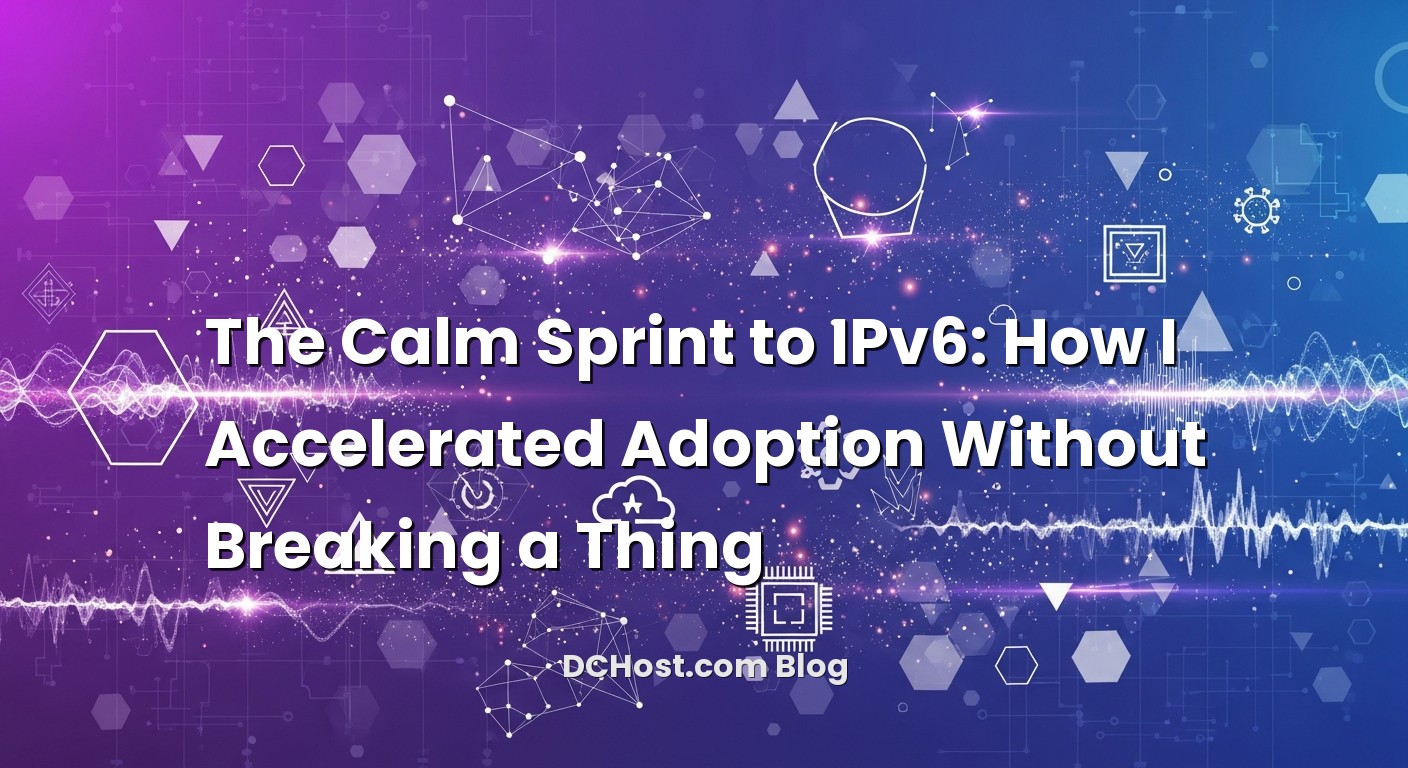It started on a Tuesday. I was staring at a dashboard and watched a perfectly good deployment fall over for a handful of mobile users we couldn’t identify. No code changes. No database drama. Just timeouts. Ten minutes later, I realized they were coming in over IPv6 and hitting an old proxy that didn’t speak the language. And it hit me—how many quiet, invisible problems were we tolerating because we’d been treating IPv6 like a nice-to-have?
If you’ve ever had that eerie feeling that your site is fine… until it isn’t, you’re in good company. IPv6 has been “coming” for ages, and yet the last mile of adoption keeps slipping down the to-do list. Meanwhile, costs, complexity, and little edge-case gremlins keep stacking up. In this post, I want to share how I’ve accelerated IPv6 adoption for teams big and small, without causing outages or turning the network into a science project. We’ll talk through the why, the how, the hidden gotchas, and a gentle roadmap you can actually finish. Think of it like upgrading a house while people are still living in it—less drama, more coffee.
İçindekiler
- 1 Why IPv6 Suddenly Feels Urgent
- 2 What IPv6 Actually Changes for Your Stack
- 3 Rolling Out Dual-Stack Safely: My Favorite Path
- 4 The Hidden Network Bits People Forget
- 5 Performance, Eyeballs, and What to Measure
- 6 A 30-Day IPv6 Roadmap You Can Actually Finish
- 7 Practical Stories and Common Questions I Hear While Rolling This Out
- 8 Clouds, Data Centers, and the Procurement Reality
- 9 Testing, Troubleshooting, and Staying Sane
- 10 One More Nudge: It’s Easier Than It Looks
- 11 Wrap-Up: The Calm Way to Accelerate
Why IPv6 Suddenly Feels Urgent
Here’s the thing: it’s not that IPv4 stopped working. It’s that the world outgrew it, and the workarounds have gotten… creative. Carrier NATs layered on provider NATs, private ranges colliding across VPNs, and elastic IPs priced like beachfront property. If you’ve been feeling slow pressure on networking, it’s not your imagination—it’s the stack asking for breathing room.
One moment I remember well: a client’s mobile conversion rate mysteriously bumped up after enabling IPv6 on their CDN. Nothing else changed. What we eventually realized is those users were on IPv6-only mobile networks with NAT64 somewhere in between. Our shiny AAAA records let them skip a translation layer and avoid a little jitter, a little packet loss. A small tweak, quietly paying rent every day.
If you want the backstory on why IPv4 got tight and expensive in the first place, I’ve walked through that saga in detail here: where all the IPv4 went and why prices surged. That context matters because it reframes IPv6 from “future tech” to “today’s relief valve.” Dual-stack isn’t a fad. It’s the calm way forward.
What IPv6 Actually Changes for Your Stack
Think of IPv6 like moving from a cramped studio to a home with extra rooms. You don’t need to fill them on day one, but the space changes how you organize your life. With IPv6, that space shows up as abundant addresses and simpler routing. You don’t have to rely on NAT to wedge three departments behind one public IP, and your network stops feeling like a puzzle someone spilled on the floor.
In my experience, the biggest mental shift isn’t technical. It’s realizing that NAT wasn’t security—it was just scarcity. With IPv6, you design access deliberately. Firewalls become first-class citizens instead of a last-minute patch. Logging gets clearer because source addresses actually mean something. Your load balancers can see the world directly instead of through the fog of address translation.
On the application side, most of the time, you don’t change a line of code. Your app cares about sockets, not versions. The trick is everything around it: the listeners on your web server, the AAAA records in DNS, the reverse proxies, the monitoring agents, the WAFs, the firewalls, and the health checks. That stack either speaks IPv6 end to end, or it quietly forces your users through a maze you can’t see. I try to bring IPv6 to the edge first, then walk it inward toward the app at a pace that matches confidence and testing.
Rolling Out Dual-Stack Safely: My Favorite Path
I’ve tried fast flips, slow burns, and every shade in between. Dual-stack is the smoothest on-ramp, hands down. Here’s the flow that’s kept my blood pressure level.
Step 1: Start at the edge, then prove reachability
Get IPv6 from your provider or cloud VPC and enable it on the load balancer or CDN. Don’t touch the app yet. Publish AAAA records for a test hostname—something like ipv6.yourdomain.com—and verify from multiple networks. Use a couple of vantage points: a mobile connection, your ISP at home, and a server in another region. Try traceroutes. Try curl. Try a friend’s office. The goal isn’t perfection; it’s confidence that packets flow and TLS handshakes are happy.
Step 2: Light up your main hostname with guardrails
When you’re comfortable, add AAAA to your primary domain but keep a rollback plan. I like to stage this off-peak and leave the DNS TTL low for a while. If your edge terminates TLS, you typically don’t need to modify certificates. Modern certs and servers negotiate just fine over IPv6. If you’re curious about performance tradeoffs between certificate types, you can explore it later; first priority is connectivity.
Step 3: Watch real user traffic and logs
I can’t stress this enough: the moment you publish AAAA, you’ll learn things about your audience. Which ISPs prefer IPv6. Which markets rely on IPv6-only mobile networks. Where intermediate boxes behave oddly. This is where dashboards become storytelling tools. If your platform supports it, split analytics by IP version. Keep an eye on 4xx/5xx rates by v4 vs v6—not to obsess, but to catch outliers quickly.
Step 4: Bring IPv6 deeper, selectively
Once the edge is stable, extend IPv6 inward where it makes immediate sense: origin connections from the CDN or load balancer to your web tier, health checkers, and monitoring. If your database network is complicated, don’t rush it. You can run mixed backends for a while. The goal is to reduce translation layers hop by hop. Any place where NAT was a bandage, consider replacing it with direct addressing and clean firewall rules.
The Hidden Network Bits People Forget
IPv6 isn’t hard so much as it’s particular. A few small details make or break the experience, and once you’ve internalized them, things get pleasantly boring.
ICMPv6 isn’t optional
In IPv4 land, you could block ICMP and muddle through. In IPv6, that’s like telling the network to whisper instead of speak. Path MTU discovery depends on it. Neighbor discovery depends on it. Router advertisements depend on it. If you block ICMPv6 blindly, you’ll invite random slowness and mysterious timeouts. Let the essential types through. This isn’t “opening a hole,” it’s letting the protocol function.
Router Advertisements, SLAAC, and DHCPv6
This is where people’s eyes glaze over, and I get it. The practical takeaway: decide how your hosts get addresses—SLAAC (stateless autoconfiguration), DHCPv6, or both—and be consistent per segment. For servers, I usually prefer static or DHCPv6 reservations to keep inventory clean. For user subnets, SLAAC with privacy extensions keeps the noise down. Stability matters more than elegance here.
Don’t rely on NAT for “security” anymore
NAT gave a comforting illusion: “No one can reach me because they don’t know where I live.” With IPv6, your hosts have globally routable addresses. The security line moves to the firewall and your policy. That’s a good thing—it’s explicit. Create inbound rules intentionally, default-deny everything else, and log decisions you’ll need to explain later. Your threat model gets clearer when addresses aren’t smudged together.
Mind the MTU
Jumbo frames are lovely in the data center, but out on the wild internet, packets take all sorts of paths. If you notice odd hangs on specific networks, suspect a PMTUD issue. Ensure your edge allows the right ICMPv6 messages and your tunnels (if any) adjust MTUs correctly. I once chased a “random” upload bug for a week only to find a mis-sized tunnel shaving bytes off packets silently. Lesson learned.
Performance, Eyeballs, and What to Measure
When people ask if IPv6 is faster, I give an honest shrug: it depends. I’ve seen it be faster when IPv4 routes detour through CGNAT mazes, and I’ve seen it be the same because good networks are good in both families. The real point is reachability. You want the shortest, cleanest path for the user you actually have. Dual-stack lets the client choose, and modern clients are smart about it.
Happy Eyeballs—great name, great idea—tries both IPv4 and IPv6 quickly and picks the winner. That means enabling IPv6 almost never hurts, and often helps for users on v6-friendly networks. If you’d like a quick reality check on where the world is, have a look at Google’s IPv6 adoption dashboard and APNIC’s live measurements. It’s eye-opening to see how regions and ISPs differ.
What should you measure? I like three simple things. First, error rates by IP version at the edge. Second, time to first byte split by v4 vs v6—nothing fancy, just watch the lines for drift. Third, CDN hit ratios and origin connections by version. If your CDN talks IPv6 to your origin, you might dodge an internal NAT layer and pick up small gains you can feel at scale. The magic is not obsessing over decimals; it’s catching bad routes and regressions quickly so you can route around them.
If you’re new to enabling IPv6 on your CDN or reverse proxy, resources like Cloudflare’s approachable IPv6 guide can help you map settings to real-world behavior. In practice, flipping the switch is the easy part. The craft is in testing, watching, and adjusting.
A 30-Day IPv6 Roadmap You Can Actually Finish
I like short, punchy projects that end with high fives instead of post-mortems. Here’s a simple month-long plan I’ve used with teams that don’t have a spare network engineer hiding under the desk.
Week 1: Inventory and one clean edge
List your edges: CDN, load balancers, web entry points, APIs. Call your provider if you don’t have IPv6 yet—most will allocate a prefix without drama. Pick one edge that’s low risk and enable IPv6 there, behind a test hostname. Publish an AAAA. Verify from a few vantage points. Make sure your firewall rules allow the essentials, including ICMPv6. Keep notes. You’ll reuse them.
Week 2: Main hostname, low TTL, watch the graphs
Add AAAA to your primary domain during a quiet window. Keep TTL low. Watch logs, health checks, and error rates. If your edge terminates TLS, you likely won’t touch certificates or ciphers. If you’re doing mTLS or more advanced TLS setups, test a staging hostname with real clients first. Don’t guess—try it.
Week 3: Origin and internal hops that matter
Let the CDN or load balancer reach your origin over IPv6 if both sides support it. This cuts out internal NAT and reduces complexity right where traffic concentrates. Update monitoring agents and health checkers to prefer IPv6, or at least to test both paths. Validate that logs preserve client IP version information at every hop. You want observability more than perfection.
Week 4: Email, DNS hygiene, and hardening
If you run inbound mail, consider publishing AAAA for your MX and ensure reverse DNS (ip6.arpa) is configured for the servers that send mail. Update SPF to include any IPv6 sending ranges if you send directly. Some teams prefer to keep outbound mail on IPv4 initially; that’s fine. On the DNS side, ensure every public-facing hostname has the right AAAA alongside A. And take a last pass at firewall policy: default deny inbound, allow what you intend, allow necessary ICMPv6, and document the reasoning. That doc page will save you three future escalations.
By the end of the month, you’re dual-stack in the places that matter most. No fanfare, no fireworks. Just fewer translation layers and a friendlier path for the users you care about.
Practical Stories and Common Questions I Hear While Rolling This Out
One of my favorite rollouts started because a developer on the team couldn’t load staging from her apartment. She was on a mobile ISP that preferred IPv6, our staging CDN node was v4-only, and the detour was fragile. We started with a staging AAAA and watched failures melt away. That same team later cleaned up an internal NAT nest they’d been afraid to touch, because dual-stack made routes legible again. Momentum matters.
Another client had a fleet of IoT devices phoning home. NAT had masked how often they switched networks and how many were quietly colliding on overlapping private ranges. With IPv6, they could uniquely identify device groups without hopping through database contortions. No code rewrite, just better plumbing.
And yes, I still see folks worry that “turning on IPv6 will break everything.” My honest take: the breakages tend to be loud and fixable (like a firewall rule too strict) rather than subtle. The subtle ones were already there—IPv6 just helps you see and route around them. Give yourself a safe pilot and you’ll be surprised how anti-climactic it feels.
Clouds, Data Centers, and the Procurement Reality
Cloud providers have matured a lot here. Spinning up IPv6-only subnets with NAT64 to reach IPv4, or dual-stack load balancers, is far less dramatic than it used to be. In data centers, most reputable transit providers will happily hand you v6 alongside v4; sometimes it’s just an underused checkbox in your ticketing portal. If you’re stuck because a legacy firewall can’t do IPv6 properly, that’s not a blocker—it’s a prioritization note. Keep IPv6 at the edge, and plan the hardware refresh when it makes sense.
I’ve also seen teams worry about the blast radius of “IPv6-only.” For public sites, dual-stack keeps things calm. For internal microservices, IPv6-only clusters work if your tooling and observability are ready. But there’s no prize for doing it in one leap. You can add IPv6 where it gives you leverage—CDN to origin, edge to service, service to database—one hop at a time.
When someone asks about business value, I gently point them back to the invoice line items that grew over time. Renting more public v4, juggling overlapping RFC1918 ranges, buying middleboxes to translate traffic—all of that is friction that IPv6 reduces. It’s not just speed. It’s fewer surprises.
Testing, Troubleshooting, and Staying Sane
My favorite tests are boring. Fetch a page over IPv6 from a couple of networks. Do it again tomorrow. Keep a little script in CI that curls your health endpoint via v6 and fails loudly if something drifts. Add a canary that warns you when your AAAA records disappear during a DNS change. These aren’t trophies; they’re seatbelts you forget you’re wearing.
When something misbehaves, I mentally walk the path: DNS returns AAAA, the client picks v6 (or not), the edge terminates TLS, the origin sees the request, logs show the real client IP, and the response flows back at a sane MTU. Any gap becomes a question. Do we see the SYN? Is ICMPv6 allowed for PMTUD? Is the route table asymmetric? The process is less glamorous than clever, which is exactly why it works.
If you want an easy place to begin, start by making sure your public content and APIs are reachable over IPv6. Let the internet meet you where it already is. Then, as time and comfort grow, bring that clarity deeper into your stack. You’ll feel it in your change windows—the temperature drops.
One More Nudge: It’s Easier Than It Looks
When I look back at the teams that did this calmly, they all had one thing in common: they started small but didn’t stall. A test hostname here. A low-TTL rollout there. A quick dashboard split. Every little step built momentum. If you need a sign to begin, consider this it. Even a single AAAA record on a CDN-backed hostname is a meaningful step forward.
And if you’re curious about the wider ecosystem, you’ll find friendly, practical reads like Cloudflare’s approachable IPv6 guide and neutral snapshots like Google’s IPv6 adoption dashboard. When the numbers move, they don’t move alone. Your audience is already there.
Quick note on tunnels
Sometimes you can’t get native IPv6 from a provider. Tunnels can be a short bridge for testing and learning, but I treat them like scaffolding around a building: useful during construction, not something you live with forever. Native beats clever nine times out of ten.
Wrap-Up: The Calm Way to Accelerate
Let’s bring it home. Accelerating IPv6 adoption isn’t about flipping a giant switch. It’s about giving your users the shortest path, your logs the clearest story, and your team fewer moving parts to juggle. Start at the edge. Publish a test AAAA. Watch real traffic. Keep TTLs low until you’re confident. Let dual-stack carry you while you bring IPv6 deeper into the places that benefit most. It’s not flashy, but it’s quietly transformative.
If you take anything from this, let it be this: IPv6 is not a project to dread. It’s a series of small, friendly steps you can schedule between releases. Write the checklist once and reuse it. Keep your firewall honest. Let ICMPv6 do its job. Measure enough to spot trouble but not so much that you drown in charts. And when you’re ready, widen the door for the next service.
I hope this was helpful. If it nudges you to add that first AAAA record or flip the switch on your CDN, that’s a win. Ping me when you do—I love hearing those “it just worked” stories. Until then, keep it simple, ship calmly, and let the network breathe.





